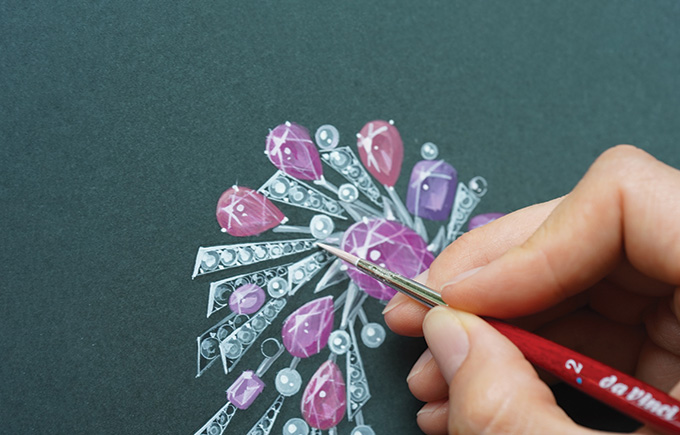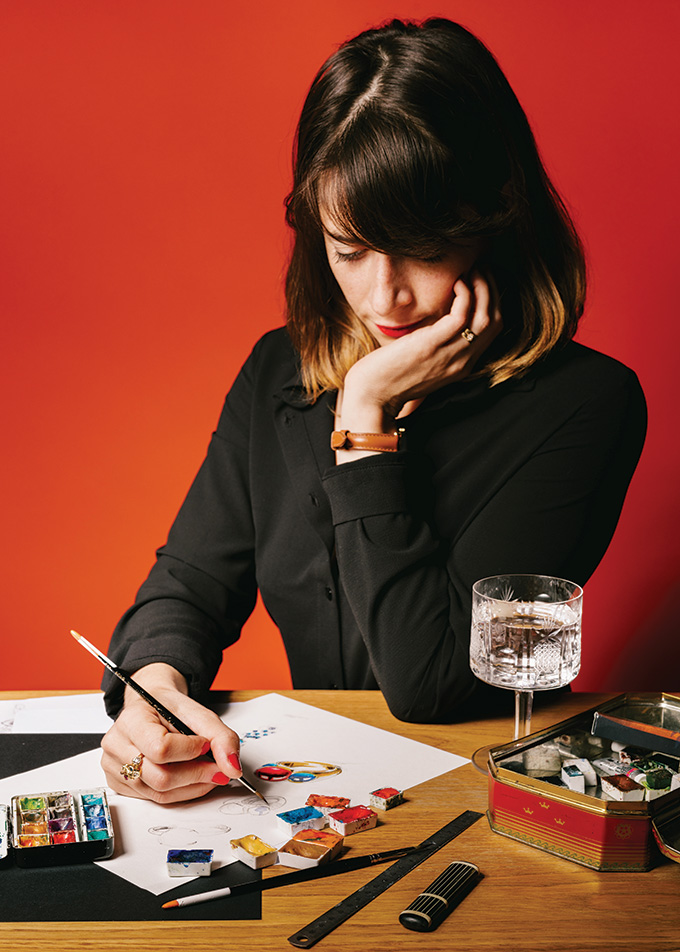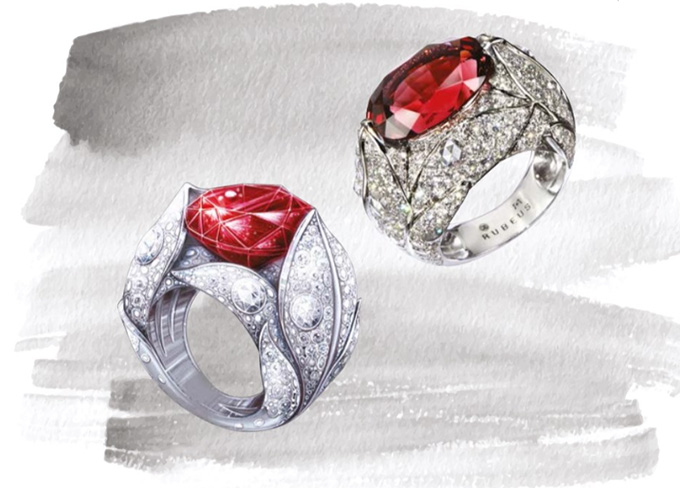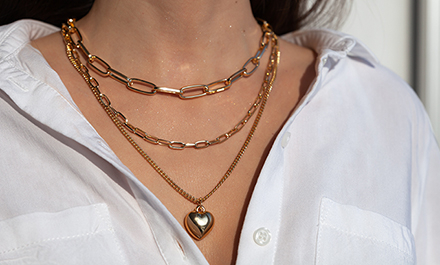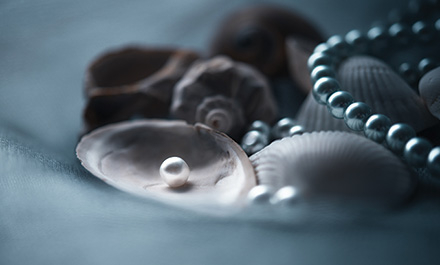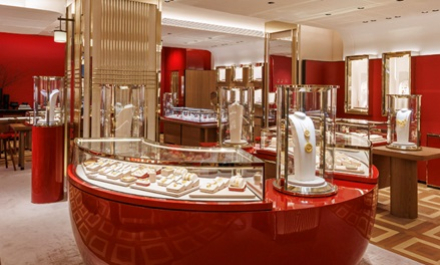In the age of sophisticated digital advancements, traditional gouache painting is regarded as a highly specialised and rare skill. Jewellery designers underscore its significance and advocate for its preservation as a prerequisite in the jewellery creation process.
This article first appeared in the JNA July/August 2024 issue.
As digital technology permeates the jewellery world, there has been a revitalised fascination with the romantic allure of drawing. Technological advancements in digital software have revolutionised jewellery design, offering precision, efficiency and expanded capabilities. While these tools are invaluable for tasks such as 3D modelling and rendering, digital rendering alone may not effectively capture creative nuances. New schools and courses thus reiterate the importance of illustration in a designer's skill set.
Working with gouache or opaque watercolour may appear deceptively simple. Like all art forms however, mastery requires dedicated study and exceptional skill. Haute Joaillerie has long championed this traditional craft, with the most prestigious jewellery houses in Place Vendôme consistently highlighting the significance of this process.
Effective dialogue
The ability to illustrate jewellery is indispensable in the design process. Although it is a classical craft, sketching can be the swiftest means of conveying ideas to clients.
Inesa Kovalova, founder of jewellery illustration school Draw me a Jewel, said, “You can do a quick sketch in a few minutes and already potentially sell your customer on the idea. Drawing allows you to communicate your vision – it is one of the most important skills of a designer. The illustration is the next step. This is optional but creates an added value.”
Jewellery designer and traditional gouache painter Claire-Chine Hardion concurs. Drawing enables designers to adjust ideas, concepts and details while listening to the client's wishes, allowing both parties to communicate spontaneously and efficiently, she noted.
Hong Kong jewellery designer Austy Lee is known for meticulously hand-drawing every piece in his sketchbook, which he calls his “visual diary.” To him, every detail, stroke, line and arc reflects the designer's experience, aesthetics, thoroughness and knowledge. In his creative process, inspiration is promptly captured and recorded, ensuring that no fleeting idea goes unnoticed.
For Taiwanese jewellery designer Anna Hu, jewellery drawing is not just about sketching designs but about bringing ideas to life, exploring possibilities and refining concepts. “Through drawing, I can visualise how a piece will look and make adjustments before moving to the production stage. It is an integral part of translating imagination into tangible pieces, guiding me from initial inspiration to the final product,” she shared.
Jewellery drawing is also the primary medium of expression for designers. Hand-drawn illustrations possess the unique ability to evoke emotions and narratives that connect deeply with clients on a personal level.
According to French jewellery designer and brand consultant Frédéric Mané, drawing by hand enables him to articulate his ideas, capturing the fluidity of his thoughts as an extension of his hand movements on paper. He said, "Drawing and then painting allow me to express my emotion as an artist and also deliver a precise real-size drawing. This enables me to make a proper quote and produce the piece with the right proportions in the workshop.”
Technical constraints
Digital renderings have significantly reduced the reliance on pencils or paint. Recent advancements in digital software have made designing jewellery more accessible. While this has its advantages, it also creates challenges in producing realistic and wearables pieces, said freelance jewellery designer, illustrator and lecturer Jennifer Rowlands.
“In a world where digital designs are prevalent, the tactile nature of hand-drawn illustrations stand out. The texture of the paper, the variations in line thickness and even the occasional imperfection add character to the artwork, making it feel more dynamic and relatable,” she explained.
Moreover, hand drawings can never be replicated exactly due to human fallibility, making each sketch truly distinctive, Kovalova disclosed. “The definition of luxury is based on scarcity. Even when we paint the same piece several times, each one would be slightly different,” she said. “There is also a natural limit in our capacity. We cannot paint an unlimited number of artworks, but technology can be applied to produce numerous replicas.”
Hardion echoes this sentiment, expressing that drawing by hand enables her to cultivate her unique artistic vision of luxury.
Hand in hand
Designers believe traditional methods of jewellery drawing can coexist and merge with digital developments. Keeping both would be more interesting and richer than squeezing one out of the process, Hardion said.
According to Rowlands, while digital tools will continue to evolve and assist in jewellery production, many craftspeople, jewellery business models and manufacturing methods still value and call for a hand-drawn illustration to start the creative process.
Like all digital tools, computer-aided design (CAD) has its limitations and cannot always capture the intricacies of one's creative vision. “Digital renderings can sometimes feel sterile or overly polished, whereas hand-drawn sketches have a rawness and authenticity that can be very compelling,” Hu remarked.
It is this human handcrafted process that remains integral to the highest echelons of fine jewellery design. Inesa Kovalova started Draw me a Jewel as an Instagram page in 2017, aimed at preserving this technique and popularising it outside of the Vendôme universe at a time when the jewellery world was placing greater emphasis
on craftsmanship.
The idea to start a school emerged from understanding the gap between industry needs and education. Kovalova said, “High jewellery companies want creative designers with strong drawing abilities. Yet many creative schools do not emphasise drawing enough, fearing it may constrain creativity. This gap leaves numerous talented designers without the drawing skills needed to excel in their careers.”
Recognising this opportunity, Draw me a Jewel pioneered the first online jewellery drawing course, and its success was immediate.
Treasured keepsakes
Gouache paintings can also be viewed as works of art, especially for bespoke creations. “For unique pieces, the hand drawing is a great addition to the overall experience and value of the piece,” said Kovalova.
Many of Mané’s original paintings are in private collections, with notable private collectors and even royal families among his clientele. “I had the honour of having my drawings enlarged in giant format on the walls of the Louvre Palace, in the Paris Museum of Decorative Arts and during the 2019 Imperial Alexandrite exhibition at the Rubeus Milano house,” he revealed.
The art of drawing is brought to a new immersive level at high jewellery art brand Qannati Objet d'Art, where Mané is artistic director. Here, clients can expect bespoke pieces meticulously tailored to their needs. “I personally sketch their dream designs by hand, which will then be manufactured in France by the best craftsmen based on my drawings,” he said.
Designers expect hand-drawing to maintain its significance in the future. Unlike computer-generated drawings, hand-drawn sketches possess a unique ability to convey the nuances of handcrafted jewellery.
Lee anticipates a rise in the appreciation of artistic jewellery and envisions having each piece come with an individual certificate from the designer. This certificate will not only authenticate the piece but also feature its design drawings and signatures. "In addition to admiring the physical jewellery, you can also delve into my insights and inspirations behind the design,” he said.
For jewellery designers working with high jewellery maisons, paintings are often archived. "When it comes to bespoke projects, clients cherish having paintings of their jewels,” Hardion revealed. “My gouache paintings are typically sent to jewellery makers and must therefore be extremely precise.”


